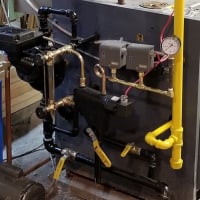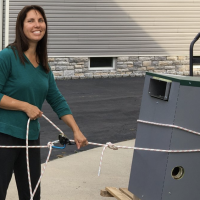Benefits of insulating the mains in the basement...

So … I finally bit the bullet and ordered a bunch of pipe insulation for all the steam piping in the basement. The house is 113 years old and has an un-insulated stone foundation that is 18" thick at the narrowest, and in some places is up to 22"+. Surprisingly, the stones do not get very cold, which I attribute (in part) to the fact that the spaces between the stones in the places where I have had to re-point the mortar is not completely filled. Therefore the thermal path through the wall is likely a bit longer than the width of the wall.
Anyway, when the boiler is firing, the temperature in the boiler room will rise about 5 degrees C (9F) higher than the thermostat set point on the first floor, and about 2.5 degrees higher in the file room (also in the basement), than the set point. In other words, I'm wasting a lot of heat in the basement!
I am using a Honeywell VisionPro 8000 thermostat, set to steam and 1cph max. I also have 3 Unifi UP-Sense environmental sensors which log the temperatures for 30 days.
Please note: I am still fine-tuning the setback temps and settings as they are a bit wonky at this time. My point in posting these graphs is to highlight that the effect of the pipe insulation is very evident on these graphs.
ALSO NOTE: The software auto-scales the vertical grid depending on the temperature coverage, so the horizontal lines are NOT consistent between the two dates.
This is a log from the 3 UP-Sense sensors for a 24 hour period from last week, 5pm to 5pm with just a couple of pieces of pipe insulation loosely installed and not taped. Outdoor temps were -24C to -32C (-11—26F) during that time period.
Here is the log from yesterday to today (also 5pm to 5pm). Outdoor temps were colder, ranging from -27 to -40C (-17 to -40F).
At this point I estimate that I have about 40% of the pipes insulated. The rest are still bare pipes.
The purple and blue lines are the boiler room and the file room on both graphs. The yellow line is the room where the thermostat is.
My setback temp schedule is:
8:15am 23.5C*
11:30am 23.0C
5:00pm 18.0C
7:00pm 18.0C
* Note the boiler kicks in early to get the house to the temperature set point by the start time for that period. It has learned the time it takes to heat the house.
Note the following interesting points:
1. The overall temperature scale of the graph (vertical axis) is lower. The top line in the first graph is 33C and in the second graph, the top line is only 28C. This is the auto-scaling referred to above.
2. Note the slower evening drop in temperature (left side of the graph) due to the ~10C difference in outdoor temperature during the period on the first graph.
3. The "night" portion of the graphs show a similar pattern (but fewer cycles) when the weather was warmer (the first graph).
4. The most dramatic difference is the daytime portion of the graph (yellow line on the right side) of the second graph shows the Main Floor temperature higher than the file room temperature, which means that more of the heat is getting to the registers upstairs. This is exactly the result I was hoping for, from installing the insulation.
I hope to get most of the rest of the insulation installed next weekend, and I will post some more graphs next week.
Other observations:
1. I'm not sure that setting the system back from 23.5C to 18C is very efficient because of the LONG RECOVERY TIME (over 3 hours of continuous boiler run time).
2. My boiler has NEVER cycled off on pressure, which means it never heats all the radiators all the way across, which means it is undersized for all of the attached radiation, including the bare pipes that I am now insulating. Perhaps, and I am hoping, that insulating the pipes will improve the radiators fully heating and thus heating the house faster and more efficiently.
3. I will still have a lot of tweaking to the thermostat set points and I anticipate having to adjust radiator venting.
If anyone wants more info on the Unifi environment sensors let me know. It would be terribly difficult to do this analysis without them.
Comments and suggestions welcome.
Weil-McLain EG/PEG -50
175K/145K in/out (454 sf)
Comments
-
I'd use a smaller setback. Perhaps around 2 Celsius rather than 5. That will help by keeping the boiler runtime coming out of the setback down.
But — insulating your steam pipes in the basement will make a difference. In fact, it may make a very considerable difference in all three of your conerns: run time, not heating all the radiators, and heating up the basement.
Br. Jamie, osb
Building superintendent/caretaker, 7200 sq. ft. historic house museum with dependencies in New England0 -
With all due respect to Jamie I will continue to differ regarding the setbacks. Your total temperature differential with the outside impacts total energy usage the most, pure and simple and I have shown year to year heating degree day normalized data in the past supporting such. Personal comfort preferences is another thing. You must avoid building pressure (shouldn't see anything over 0.5psi) during the recovery by which there are many methods to do so. I do a 6 degree recovery over 3 hours but my boiler runs only 50% of that time on the coldest mornings. Usually less than 50% of the time.
0 -
Thanks to both of you for your input on the set backs. We have had some wicked cold weather here the last few weeks, with -40C nighttime temps and close to -60C (-76F) windchills in the heart of the Canadian prairies.
@dabrakeman, I am wondering what your "coldest morning" temperatures are? The graphs in my original posts show my system is on for a full 3+ hours when it is recovering in the morning with the -40C/F temps we have had in the last week. I have never seen the system at more than a couple of ounces of pressure, even after several hours of continuous firing. I installed a new 3psi pressure gauge about 2 years ago, (in addition to the 30psi required gauge) and which I test regularly.
As of today, I am already noticing a difference in the heat distribution in the house since partially insulating the pipes. I anticipate having to tweak the venting on the radiators to get a more even heat distribution.
Single pipe steam
Weil-McLain EG/PEG -50
175K/145K in/out (454 sf)1 -
The cool thing is -40 is the same in C and F and my dad grew up in Saskatchewan and told me he used to crunch around in -40 temps so thanks for the memory there.
I must admit that even though here in NJ I think insulated mains are pretty much not worth the effort and expense, depending on the basement (even though I did mine), I have no doubt they are going to be good for your situation, especially with a possibly undersized boiler.
They are good for putting less heat in the basement and more heat upstairs, for sure.
NJ Steam Homeowner.
Free NJ and remote steam advice: https://heatinghelp.com/find-a-contractor/detail/new-jersey-steam-help/
See my sight glass boiler videos: https://bit.ly/3sZW1el0 -
Insulating your mains will provide the radiators with better quality steam, which means the BTUs delivered to the radiators will be a greater percentage of the BTU's produced by the fuel.
It may also help remedy certain shortcomings of the system piping.
0 -
How would insulation provide better quality steam?
NJ Steam Homeowner.
Free NJ and remote steam advice: https://heatinghelp.com/find-a-contractor/detail/new-jersey-steam-help/
See my sight glass boiler videos: https://bit.ly/3sZW1el0 -
Why do you think they bothered insulating mains when #6 Oil was 3-cents/gallon? It wasn't to save money!
The more latent heat that is lost in the mains, the less latent heat that is available to the radiators.
or… you can say
Minimizing the condensing of steam in the mains will minimize the loss of BTU, and assure the steam is as close to dry as it was when leaving the header.or…you can say
If your steam is leaving the pipes in heating the basement, they'll be less of it to heat the radiators. The steam reaching the radiators will be wet, thereby containing less latent heat.
and…
Paul, I was looking forward to meeting you on Saturday.
1 -
I will have to make the next one!
NJ Steam Homeowner.
Free NJ and remote steam advice: https://heatinghelp.com/find-a-contractor/detail/new-jersey-steam-help/
See my sight glass boiler videos: https://bit.ly/3sZW1el0 -
@ethicalpaul My Mom also grew up in Saskatchewan on a farm outside of Saskatoon. I enjoy tracking weather on my weather app for various cities so noticed indeed just last week they were less than -30F multiple nights and just hit -40F one night. Not too abnormal. I recall standing at the bus stop as a kid in Vermont at -35F which is the coldest outdoor temperature I have experienced (they didn't cancel school in those days). In college I worked in an ice research lab so would fiddle with ice samples in a cold box at -50F. For a minute or two was nice in the summer…
@Powe The coldest temperatures I am talking about here in Michigan are about -10F this winter. My recovery is artificially broken up by thermostat programming turning the boiler on and off for a series of 1/2 hour increments. Radiators are still putting out heat during the off cycles so temperature steadily rises. I also have an oversized boiler to deal with. Works fine for temperatures down close to -10F. Any lower I would likely reduce the setback for that night. If I were experiencing -40F I likely might not do a setback since I don't think my system would keep up on the recovery given the radiation I have in the house was not designed even back in the day for those temperatures plus some of the radiators have been moved around reducing the overall standing radiation in the house from original. I would likely also lower my swing temperature to 1/2 degree when that cold since otherwise individual cycles might start building pressure in my case. Sounds like you have a much more properly sized system and thus can still get away with your setbacks at that temperature.
1
Categories
- All Categories
- 87.3K THE MAIN WALL
- 3.2K A-C, Heat Pumps & Refrigeration
- 61 Biomass
- 429 Carbon Monoxide Awareness
- 120 Chimneys & Flues
- 2.1K Domestic Hot Water
- 5.8K Gas Heating
- 114 Geothermal
- 166 Indoor-Air Quality
- 3.7K Oil Heating
- 77 Pipe Deterioration
- 1K Plumbing
- 6.5K Radiant Heating
- 395 Solar
- 15.7K Strictly Steam
- 3.4K Thermostats and Controls
- 56 Water Quality
- 51 Industry Classes
- 50 Job Opportunities
- 18 Recall Announcements





